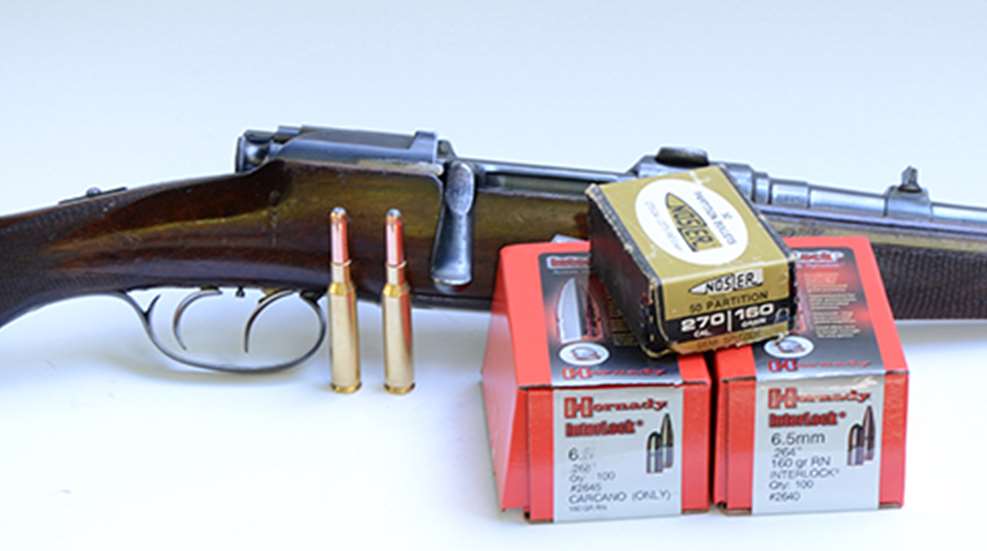
Several years ago I received an invitation to hunt moose in Sweden as a guest of Norma, and decided to take an Ultra Light Arms rifle in .358 Norma Mag. I also wanted to load the cartridge with Norma bullets and, while a box was on hand, they were 9.3 mm. Using a draw die, I reduced their diameter from 0.365 inches to 0.358 inches. Doing so obviously had no adverse affect on accuracy as the modified bullets punched out smaller groups from the .358 Norma Mag. than when shot at their original diameter from my Sako rifle in 9.3x62 mm Mauser. Several weeks later one of them accounted for the best bull taken by the host hunting club members and their guests during that year.
As Dave Corbin of Corbin Mfg. pointed out to me, bullet-reducing (or drawing) is just the opposite of bullet swaging. Swaging a bullet requires the application of pressure to a lead core placed inside a jacket. The core expands and pushes the wall of the jacket hard against the wall of the die, thereby increasing diameter. When pressure is relieved, the bullet springs back a bit, releasing its grip on the wall of the die so the bullet can be removed.
The drawing process entails pushing a finished-jacketed bullet through an annular die. To compensate for springback, the interior of the die is hand-reamed and polished a few millionths of an inch smaller than the desired bullet diameter.
The amount of springback varies for different types of jacketed bullets, but is usually less than 0.0015 inches. If a die is reamed to reduce the diameter of the Sierra MatchKing, it may work equally well with other thin-jacketed target bullets of the same caliber made by Berger, Hornady, Lapua and others. It probably won’t be exactly correct for thicker-jacketed bullets such as the Nosler Partition and Swift Scirocco II, and the difference may or may not affect accuracy.
Plenty of good 0.358-inch bullets were available when I hunted moose in Sweden so drawing the rounds was not a necessity, rather just a preference. Such is not the case for some cartridges. An example is an old wildcat called the .333 OKH, which was cooked up by Charles O’Neil, Elmer Keith and Don Hopkins. Before Fred Barnes and Vernon Speer started making bullets of that diameter during the early 1950s, they had to be imported from England where they were made for the .333 Jeffery. Today, owners of rifles chambered for the .333 OKH or its belted litter-mate, the .334 OKH, as well as the .333 Jeffery, are not likely to find the bullets they need on the shelves of their local gun shop. But 0.338-inch bullets made for .338 Win. Mag. and others of its caliber are easily squeezed down to 0.333 inches.
There are even more rifles out there in .318 Rimless Nitro Express or .318 Accelerated Express as its developer, Westley Richards, called it. Its 0.330-inch bullet can also be formed from those measuring 0.338 inches.
For many years I have owned a Model 1903 Mannlicher-Schoenauer in 6.5x54 mm, and I find that groove diameter in those rifles varies considerably. My rifle measures 0.2652 inches and the Hornady 160-gr. round-nose bullet (No. 2640) measuring 0.264 inches averages 4-inch groups at 100 yds. Loaded to 2,200 f.p.s., it shoots to point of aim with the open sights and since everything I have shot with that rifle has been inside 100 long paces, I am content with its accuracy.
A friend of mine is not so lucky. The groove diameter of his rifle is 0.2663 inches and it shoots all over the paper with the Hornady 0.264-inch bullet. But Hornady makes another 160-gr. round-nose bullet (No. 2645) for the 6.5x52 mm Carcano, and it measures 0.268 inches. When drawn down to the proper diameter for his rifle, it averages 2 inches at 100 yds. I have heard of Mannlicher-Schoenauer rifles with groove diameters even closer to 0.270 inches and for those, bullets of 0.277 inches made for the .270 Win. could be squeezed down to size.
Sometime back I had a Marlin 1895 in .45-70 Gov’t converted to .50 B&M Alaskan. Unlike the original .50 Alaskan which uses a bullet diameter of 0.510 inches, the B&M version uses 0.500-inch bullets made for the .500 S&W Mag. When the rifle cartridge is loaded to reach the higher end of its potential velocity, most of the bullets made for use in the S&W Model 500 revolver are too soft for anything bigger than deer, so I mostly use them for punching paper. For larger game, Swift makes a 0.509-inch A-Frame weighing 450 grs. and after being pushed through a 0.500-inch draw die and loaded to 1950 f.p.s., it shoots quite accurately in my rifle. I also have the option of using the 0.510 inch, 500-gr. Weldcore bullet from Woodleigh.
Then we have vintage rifles in .22 Hornet, the barrels of which have a 0.223-inch groove diameter. Sierra and Hornady offer a 0.223-inch Hornet bullet, but having a die on hand for squeezing down 0.224-inch bullets gives the owner of an older firearm more options. I have a very handsome rifle in .22 Hornet built during the early 1930s by Adolph Niedner on a 1898 Krag action. It shoots the 0.223-inch bullets from Sierra and Hornady okay, but it absolutely drives tacks with the Hornady 0.224-inch, 35-gr. V-Max squeezed down to 0.2230 inches. And of course, we must not overlook drawing down 0.323-inch bullets commonly available for the 8x57 mm JS Mauser to 0.318 inches for the 8x57mm J Mauser.
Those who own vintage handguns can benefit as well. The Smith & Wesson Model 53 in .22 Jet uses a 0.222-inch bullet and while a 45-gr. flatnose is still available from Hornady, a draw die opens the door to other options for owners of that S&W revolver.
I could continue on with other examples but my point is made; anyone who owns a firearm chambered for a cartridge with an obsolete or difficult-to-find bullet diameter is a candidate.
There are limits on how much the diameter of various bullets can be reduced without affecting accuracy. As a rule, 0.006 inches is about maximum for those of small to medium calibers, and 0.008 inches to 0.010 inches for larger calibers. But there are exceptions with jacket hardness, thickness and ductility as well as core material density sometimes becoming greater factors than the amount of reduction involved.
If diameter is reduced more than the construction and material of a particular bullet can withstand, the fit between its jacket and core can become loose. This is not a problem with bullets that have the core bonded to the jacket or a plated bullet, such as the Speer DeepCurl.
Some bullets can be reduced with the die installed in a standard reloading press. Corbin’s “S” die has the same 7/8-14 threads as a standard reloading die and screws into the top of the press. It comes with a punch used to push a bullet through the die. The opposite end of the punch is shaped like the bottom of a RCBS shell holder and snaps into the T-slot at the top of the ram of the press. Jobs requiring more power and leverage call for the greater mechanical advantage of a bullet-swaging press such as Corbin’s CSP-1. That press takes a 7/8-14 die so it can also be used for reloading cartridges.
Whether or not a bullet can be reduced in a reloading press, or requires additional leverage, more depends on its construction and hardness than its diameter. When drawing down the Woodleigh 500-gr., 0.510-inch bullet to 0.500 inches for my .50 B&M Alaskan, so little effort is required to push it through the die in my CSP-1 press, a standard reloading press would handle it quite easily. A reloading press would not have the leverage required for reducing the Swift 450-gr., 0.509-inch bullet by the same amount.
While those two bullets have bonded cores, they differ considerably in construction. The jacket of the Swift bullet is much thicker, and that along with its thick, mantel-like interior partition make it more resistant to being reduced in diameter. Since the amount of reduction required is such a small percentage of their diameter, both emerge from the die looking almost the same as they did prior to being pushed through it.
A bullet lengthens a bit when its diameter is decreased and the more it is squeezed down the longer it grows. The Swift 450-gr. bullet is 0.965-inches long at a diameter of 0.509 inches and 0.985-inches long at 0.500 inches. The 500-gr. Woodleigh is 0.995 inches before and 1.015 inches after. Although the distance from the cannelure to the nose on those bullets is increased, it does not affect overall cartridge length enough to matter in my Marlin 1895.
Samples of the bullet to be reduced have to be sent to Corbin in order to assure precise sizing of the die to compensate for springback. The customer is then informed whether it can be reduced in a standard reloading press or will require a bullet swaging press. When ordering my .50-cal. die I sent samples of the Swift A-Frame bullet because it is the one I will be using for most of my hunting with the .50 B&M Alaskan. Since the die was reamed specifically for it, I had assumed that due to differences in their construction, the Woodleigh bullet would emerge at a slightly different diameter. As it turned out, both measure precisely 0.500 inches after the reduction.
For more information on drawing down bullets visit Corbins.com.




































